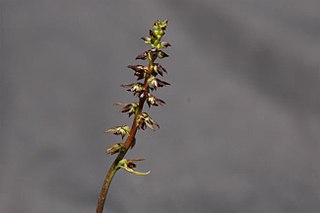
Genoplesium plumosum, commonly known as the Tallong midge-orchid or plumed midge-orchid, is a species of orchid endemic to New South Wales. It is a small orchid only known from a few sites near the towns of Tallong and Wingello on the Southern Tablelands and is only relatively easy to find for about a month, when it flowers. It has been classified as "Endangered" under the EPBC Act.

Genoplesium commonly known as midge orchids, is a genus of about 50 species of flowering plants in the orchid family, Orchidaceae and is found in Australia, New Zealand and New Caledonia. Midge orchids are terrestrial herbs with a single leaf at the base of the plant. They are similar to orchids in the genus Prasophyllum in that plants without flowers have a hollow, onion-like leaf. The flowers are small but often scented and attractive to their insect pollinators. There is disagreement about which species belong to this genus and some taxonomists suggest that most belong in the genus Corunastylis.
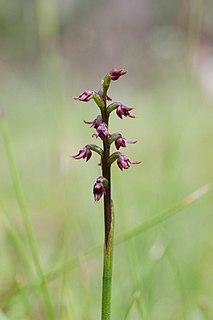
Genoplesium nudum, commonly known as the tiny midge orchid in Australia or the red midge orchid in New Zealand, is a small terrestrial orchid native to south-eastern Australia and New Zealand. It has a single thin leaf fused to the flowering stem and up to forty small, reddish-purple or green and red flowers. Australian and New Zealand authorities use the name Corunastylis nuda but Genoplesium nudum and Prasophyllum transversum are used by the World Checklist of Selected Plant Families.
Genoplesium rufum, commonly known as the rufous midge-orchid, is a species of orchid endemic to New South Wales. It has a single thin, wiry leaf and up to twenty five drooping, pinkish or reddish flowers on a flowering stem which is fused to the lower part of the leaf. It was formerly thought to range from Queensland to South Australia and Tasmania but specimens in other states are now assigned to Genoplesium clivicola.
Genoplesium nudiscapum, commonly known as the bare midge orchid, is a species of small terrestrial orchid endemic to Tasmania. It has a single thin leaf fused to the flowering stem and up to twenty small, green and reddish-brown flowers. It was thought to be extinct, since it had not been seen since 1852 but was rediscovered in 2008. The species has also been described as occurring on continental Australia. The species is known as Corunastylis nudiscapa in Tasmania.

Genoplesium filiforme, commonly known as the glandular midge orchid is a small terrestrial orchid endemic to the east coast of Australia. It has a single thin leaf and up to thirty greenish to purple flowers with a reddish-purple labellum. The edges of its flower parts are covered with many short glandular hairs. It is found from southern Queensland to southern New South Wales.
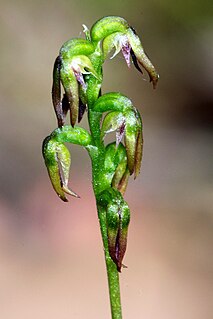
Genoplesium despectans, commonly known as the sharp midge orchid and known as Corunastylis despectans in Australia, is a small terrestrial orchid endemic to south-eastern Australia. It has a single thin leaf fused to the flowering stem and up to forty five small, dark purple or green and purple flowers.

Genoplesium morrisii, commonly known as the bearded midge orchid and known as Corunastylis morrisii in Australia, is a small terrestrial orchid endemic to south-eastern Australia. It has a single thin leaf fused to the flowering stem and up to fifteen small, dark purplish-black or green and purple flowers.
Genoplesium acuminatum, commonly known as the pointed midge orchid and as Corunastylis acuminata in Australia, is a small terrestrial orchid endemic to eastern Australia. It has a single thin leaf fused to the flowering stem and up to sixteen small, hairy, greenish purple to brownish purple flowers. It is found in coastal and near-coastal parts of New South Wales and Queensland.
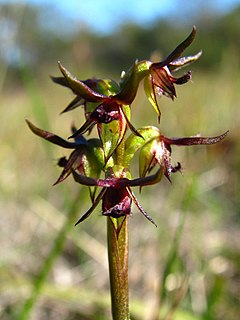
Genoplesium archeri, commonly known as the elfin midge orchid and as Corunastylis archeri in Australia, is a small terrestrial orchid endemic to south-eastern Australia. It has a single thin leaf fused to the flowering stem and up to fifteen small, hairy, yellowish green flowers with purple stripes. It grows in a wide range of habitats in New South Wales, Victoria and Tasmania.

Genoplesium arrectum, commonly known as the erect midge orchid and as Corunastylis arrecta in Australia, is a small terrestrial orchid endemic to south-eastern Australia. It has a single thin leaf fused to the flowering stem and up to twenty small, dark purple flowers. It grows in a montane and subalpine grassland and forest in Victoria and the Australian Capital Territory.
Genoplesium brachystachyum, commonly known as the Rocky Cape midge orchid or short-spike midge orchid, is a species of small terrestrial orchid endemic to Tasmania. It has a single thin leaf fused to the flowering stem and up to twelve small, green to brownish green, and reddish flowers. It usually grows in heath in rocky places near the coast.
Genoplesium eriochilum, commonly known as the Mount Wilson midge orchid, is a species of small terrestrial orchid endemic to the Blue Mountains. It has a single thin leaf fused to the flowering stem and up to twenty small, crowded, dark purplish brown flowers. It usually grows between low shrubs and sedges.
Genoplesium firthii, commonly known as Firth's midge orchid, is a species of small terrestrial orchid endemic to Tasmania. It has a single thin leaf fused to the flowering stem and up to six small, yellowish green or reddish flowers with a red labellum. It grows in coastal heath and scrub and is currently known only from a single population of about twelve plants near Coles Bay.
Genoplesium parvicallum, commonly known as the mountain-top midge-orchid, is a species of orchid which is endemic to Queensland. It is a small orchid with up to twenty five greenish flowers with purplish brown marking and is only known from mountaintops in the McPherson Range. It is treated as Corunastylis parvicalla in Queensland.

Genoplesium pumilum, commonly known as the green midge orchid in Australia, and the yellow gumland leek orchid in New Zealand is a small terrestrial orchid native to south-eastern Australia and New Zealand. It has a single thin leaf fused to the flowering stem and up to twenty five green to yellowish-green flowers which sometimes have red markings. Australian and New Zealand authorities use the name Corunastylis pumila.
Genoplesium sagittiferum, commonly known as the horned midge orchid, is a species of small terrestrial orchid that is endemic to New South Wales. It has a single thin leaf fused to the flowering stem and up to ten small, yellowish-green flowers with a hairy reddish labellum.
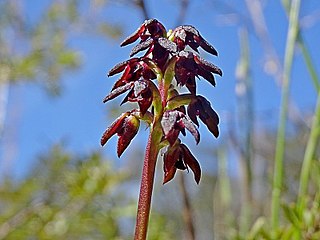
Genoplesium vernale, commonly known as the spring midge orchid or East Lynne midge orchid is a small terrestrial orchid which is endemic to a small area on the south coast of New South Wales. It has a single thin leaf and up to twenty five dark purplish-black flowers with tiny glandular hairs on the sepals and petals.
Corunastylis densa, commonly known as the dense midge orchid, is a small terrestrial orchid endemic to eastern Australia. It has a single thin leaf fused to the flowering stem and up to twenty five densely crowded reddish-brown to dark purplish-brown flowers. It is found between the New England National Park and the Moroka River.
Corunastylis trifida, commonly known as the blackish midge orchid, is a small terrestrial orchid endemic to New South Wales. It has a single thin leaf fused to the flowering stem and up to twenty five dark purplish-black and green flowers. It grows in heath in scattered places in the Sydney basin.










